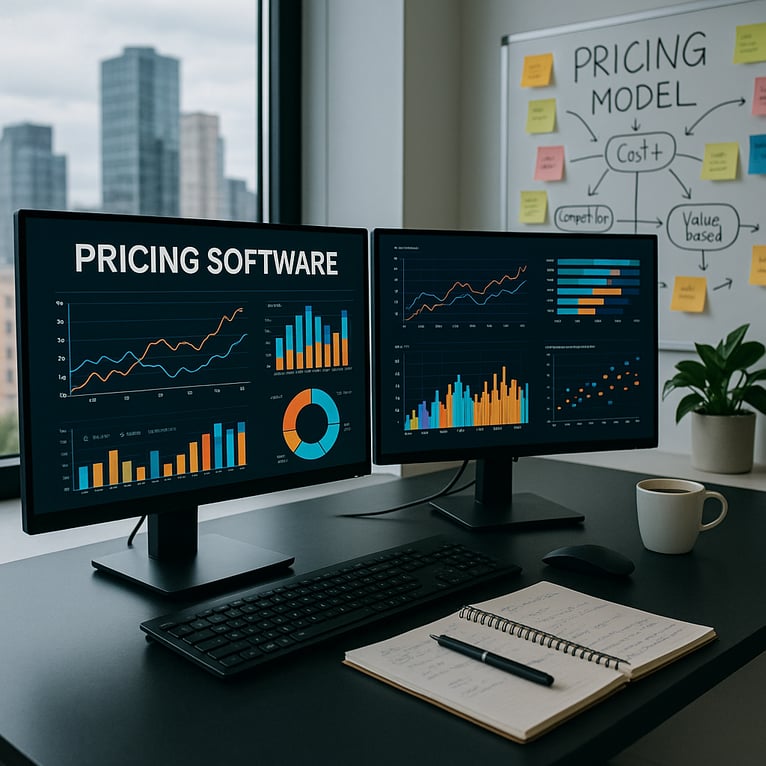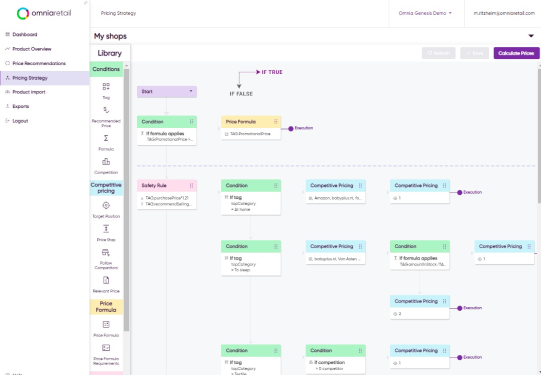In theory, buying pricing software should be straightforward: you define your requirements, compare a few platforms, and choose the one that suits your needs.
In practice, however, the process tends to unfold quite differently. What starts as a clear objective quickly becomes a marathon of internal meetings, overlapping stakeholder priorities, vendor pitches that blur together, and spreadsheets that never seem to tell the full story.
If you're in the middle of this process or about to start, this guide is for you. We’ve gathered the key steps, questions, and realities pricing and category managers face when selecting a solution. Whether you’re replacing legacy tools, scaling pricing operations, or building a business case for the first time, the goal is the same: make a confident, informed decision without wasting time or getting lost in the process.
Let’s start with the biggest friction point most teams face.
Before Entering the Buying Process, You Need a North Star
Buying pricing software today isn’t a lack-of-information problem; it’s a too-much-of-everything problem. Once you begin exploring options, it doesn’t take long before your team has a desktop bar full of open tabs, overlapping product pages, and debates features that weren’t even part of the original discussion.

Source: Gartner, 2018
The volume of vendors, tools, and solutions creates a sense of momentum, but not necessarily progress. Everyone is moving, but the directions are getting messy, and no one is moving in the same direction.
Internally, decision-makers often bring different goals to the table, and the individual wishlists can look something like this:
- IT wants security, control, and less individual code.
- Category managers want AI, filters, reports, and user management—all in one solution.
- Marketing wants insights and reports.
- Leadership wants scalability and a positive ROI.
Without a clear north star to align around, even well-organized teams find themselves revisiting conversations they thought were already settled.
Tools like G2 and comparison pages are helpful starting points; they give a snapshot of the market and surface key players. But when many platforms list similar features like automation, insights, or dynamic updates, it becomes harder to understand what truly sets each apart. That’s why it helps to go deeper. Look for where a solution’s core strengths align with your team’s goals, and create a clear list of internal priorities before jumping into demos. The more focused your decision criteria, the easier it is to spot which vendors are built for what you actually need.
The challenge goes beyond choosing the right pricing software, it’s creating the right conditions for your team to make a choice at all, and to feel confident in it. That’s why the most effective buyers start with alignment, not just a list of features.
Simplify Before You Buy: Internally Align First
The easiest way to complicate a software purchase is to start comparing vendors before your team agrees on what you actually need.
This happens more often than most buyers would like to admit. One department focuses on speed. Another wants transparency. A third cares mostly about reporting. Everyone’s aligned on buying something, but not on why or what success should look like once the software is in place.
Before you even send a brief or book a demo, it’s worth doing a short internal check-in. Think of it less like a formal requirements document and more like a shared set of answers to a few key questions.
Try starting here:
- What are the real problems we’re trying to solve with pricing software?
- Which metrics or outcomes will help us know if it’s working?
- Which teams need access, and what do they care about?
- What systems do we need the pricing software to connect with?
- Where do we need flexibility, and where do we need consistency?
You don’t need perfect answers, but even a rough alignment will save you weeks of confusion later. It also gives your buying team a stronger position when evaluating vendors; you’ll ask more insightful questions and move through the process with less friction.
At the enterprise level, this alignment becomes even more important because the more teams involved, the more touchpoints the dynamic pricing software will affect. Getting everyone on the same page early can be the difference between a quick rollout and a drawn-out re-evaluation six months in.
Want to find out how Dynamic Pricing works for your industry?
/Price%20Recommendations%20by%20Omnia%20Retail_v2.png)
Forget Long Feature Lists, Ask These Questions Instead
It’s common to start the buying process with a feature list, and for good reason. It helps teams clarify what’s important, compare options, and document requirements. But once you start reviewing multiple tools, those lists can blur, because on paper, many platforms check the same boxes, which makes it harder to see what sets them apart.
That’s where context matters. A feature might exist, but how it behaves in real workflows, across teams, channels, or data structures, can vary widely. And there’s no spreadsheet column for how well a vendor communicates or adapts once the rollout begins.
A better approach is to focus on questions that reveal how well a tool fits your actual needs. Here are a few questions worth asking before the demo slides begin:
1. How is your market data collected?
If you’re relying on pricing data to drive decisions, the source matters. Ask if the price monitoring vendor uses in-house scraping, third-party aggregators, or a mix. And dig into the frequency and flexibility — Can you set country- or channel-specific rules? Can you get data at the frequency you need, whether it's 12x per day or 1x per month? Make sure you can select a suitable frequency for each product group individually, so you don't pay for higher frequencies for your long tail.
2. Can I benchmark performance across channels?
For multi-channel brands, visibility across Amazon, Google Shopping, and D2C benchmarking across channels is essential. A good tool should let you compare pricing dynamics across those touchpoints without needing a separate analysis each time.
3. How much control do I have over pricing logic?
Whether you want to fully automate or keep things hands-on, make sure the software supports your ideal level of control. That means more than just “rules-based” pricing, look for approval flows, override options, and smart fallbacks.
4. What does onboarding actually look like?
Ask for specifics here. How long does it take? What does a successful rollout look like for similar companies? Who’s responsible for implementation, and what does support look like after go-live? And what are the challenges often encountered in your specific vertical? Dig a bit to see if they have experience with your type of products.
5. How do you help us adapt if our setup changes?
Your business might grow into new markets, shift categories, or restructure teams, and a rigid solution becomes a liability fast. Look for vendors who talk openly about flexibility, scaling, and change management, not just initial setup.
These questions are as important for vendors as for internal team alignment. The best software decisions go beyond capability and look at the context and whether the tool is designed to move with you, not around you.
The Two Dimensions of a Successful Software Purchase
A strong pricing platform needs to check two boxes: it should work the way you need it to, and it should come with a partner you trust.
Most buyers focus on the first part of what the tool can do, but the second part, how the vendor operates, matters just as much. Especially once you’re past onboarding and into the everyday use of the platform.
Let’s break it down.

1. Technical satisfaction
Can the software meet your pricing needs today and grow with you tomorrow? This part focuses on system fit. You want to know that it integrates with your current tech stack, supports the way your team works, and delivers pricing logic that reflects your strategy.
Ask how other enterprise clients are using it. Push for real examples and make sure the answers match your specific use case, not just a generic slide deck.
2. Partnership satisfaction
Are the people behind the platform honest, proactive, and invested in your success? B2B software is never just about software, you’re choosing the team that will support your setup, troubleshoot issues, flag blind spots, and evolve with you as your business changes.
Look for signals that the vendor is upfront about what’s possible and what isn’t. Do they challenge assumptions? Do they communicate clearly? Are they responsive when things shift internally?
Too often, buyers only discover this part after the contract is signed, but by then, it’s harder to course-correct. Bring partnership criteria into your selection process early, not just as a gut check, but as part of how you evaluate fit.
Don't trust bold promises of results in the beginning. The first steps are always a bit tricky, but what truly matters is that the results of the test are convincing.
In Summary, What Makes a Good Buying Process
By the time most teams buy pricing software, they’ve already spent a long, long time just getting to the starting line. The internal alignment, data prep, the back-and-forth, and the vendor research. It all adds up.
But the buyers who move through this process with the most clarity usually share one thing: they’re not chasing the perfect tool, but looking for the right fit.
That means aligning internally before evaluating externally. Asking sharper questions instead of longer ones and seeing the vendor relationship as part of the product, not just the contract that wraps around it.
Pricing software plays a central role in how you operate, compete, and grow. The buying journey should reflect that, but it doesn’t have to drag. With the right structure and a clear sense of what matters most to your team, the process gets easier. And the decisions get better.
FAQ
Who should be involved in writing the RFP?
Bring in key stakeholders from pricing, category management, e-commerce, marketing, IT, and finance. Their input ensures the RFP reflects real needs and increases adoption later.
How long does it take to write and run an RFP process?
It depends on your company size and complexity, but most teams spend 2–6 weeks drafting the RFP and 4–8 weeks evaluating vendors. Build in time for alignment, demos, and Q&A.
How do I compare dynamic pricing vendors fairly?
Create weighted evaluation criteria that reflect both technical needs and strategic goals. Ask each vendor to walk through real use cases, not just generic demos.
How can I ensure the pricing software integrates with my existing systems?
Include specific data sources (e.g., ERP, PIM, e-commerce platforms) and ask vendors to detail how their solution handles both inbound and outbound integrations.
Read more about interesting pricing strategies here:
- What is Dynamic Pricing?: The ultimate guide to dynamic pricing.
- What are the best pricing strategies?: Read about 17 pricing strategies for you as a retailer or brand.
- What is Price Monitoring?: Check out everything you need to know about price comparison and price monitoring.
- What is Value-Based Pricing?: A full overview of how price and consumer perception work together.
- What is Charm Pricing?: A short introduction to a fun pricing method.
- What is Penetration Pricing?: A guide on how to get noticed when first entering a new market.
- What is Bundle Pricing?: Learn more about the benefits of a bundle pricing strategy.
- What is Cost Plus Pricing?: In this article, we’ll cover cost-plus pricing and show you when it makes sense to use this strategy.
- What is Price Skimming?: Learn how price skimming can help you facilitate a higher return on early investments.
- What is Map Pricing?: Find out why MAP pricing is so important to many retailers.



.png?height=766&name=Untitled%20design%20(21).png)

